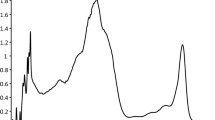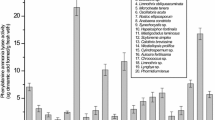Abstract
Several standard in vitro assays were performed in order to determine the potential antioxidant capabilities of purified aqueous extracts of the mycosporine-like amino acids (MAAs), porphyra-334 plus shinorine (P-334 + SH), isolated from the red alga Porphyra rosengurttii, asterina-330 plus palythine (AS-330 + PNE), from the red alga Gelidium corneum, shinorine (SH), from the red alga Ahnfeltiopsis devoniensis, and mycosporine -glycine (M-Gly), isolated from the marine lichen Lichina pygmaea. The scavenging potential of hydrosoluble radicals (ABTS+ decolorization method), the antioxidant activity in lipid medium (β-carotene/ linoleate bleaching method) and the scavenging capacity of superoxide radicals (pyrogallol autooxidation assay) were evaluated. In terms of scavenging of hydrosoluble radicals, the antioxidant activity of all MAAs studied was dose-dependent and it increased with the alkalinity of the medium (pH 6 to 8.5). M-Gly presented the highest activity in all pH tested; at pH 8.5 its IC50 was 8-fold that of L-ascorbic acid (L-ASC) followed by AS-330 + PNE while P-334 + SH and SH showed scarce activity of scavenging of hydrosoluble free radicals. AS-330 + PNE showed high activity for inhibition of β-carotene oxidation relative to vitamin E and superoxide radical scavenging whilst the activity of P-334 +SH and SH were moderate. According to these results, the potential of MAAs in photoprotection can be considered high due to a double function: (1) UV chemical screening with high efficiency for UVB and UVA regions of the solar spectrum, and (2) their antioxidant capacity.

Similar content being viewed by others
References
Armstrong BK, Kricker A (2001) The epidemiology of UV induced skin cancer. J Photochem Photobiol 63:8–18
Arnao MB, Cano A, Hernández-Ruiz J, García-Cánovas F, Acosta M (1996) Inhibition by L-Ascorbic acid and other antioxidants of the 2,2′-Azino-bis(3-ethylbenzthiazoline-6-sulfonic acid) oxidation catalyzed by peroxidase: a new approach for determining total antioxidant status of foods. Anal Biochem 236:255–261
Asada K, Takahashi M (1987) Production and scavenging of active oxygen in photosynthesis. In: Kyle DJ, Osmond CB, Arntzen CJ (eds) Photoinhibition. Elsevier, Amsterdam, pp 227–287
Baliga MS, Katiyar SK (2006) Chemoprevention of photocarcinogenesis by selected dietary botanicals. Photochem Photobiol Sci 5:243–253
Bandaranayake WM (1998) Mycosporines: are they nature’s sunscreens? Nat Prod Rep 15:159–172
Bandaranayake WM, Bemis JE, Bourne DJ (1996) Ultraviolet absorbing pigments from the marine sponge Dysidea herbacea: isolation and structure of a new mycosporine. Comp Biochem Physiol 115:281–286
Bandaranayake WM, Bourne DJ, Sim RG (1997) Chemical composition during maturing and spawning of the sponge Dysidea herbacea (Porifera: Demospongiae). Comp Biochem Physiol 118:851–859
Bischof K, Hanelt D, Wiencke C (1998) UV-radiation can affect depth-zonation of Antarctic macroalgae. Mar Biol 131:597–605
Collen J, Davison IR (1999) Reactive oxygen metabolism in intertidal Fucus spp. (Phaeophyceae). J Phycol 35:62–69
Conde FR, Churio MS, Previtali CM (2000) The photoprotector mechanism of mycosporine-like amino acids. Excited-state properties and photostability of porphyra-334 in aqueous solution. J Photochem Photobiol 56:139–144
Conde FR, Churio MS, Previtali CM (2004) The deactivation pathways of the excited-states of the mycosporine -like amino acids shinorine and porphyra-334 in aqueous solution. Photochem Photobiol Sci 3:960–967
Darr D, Dunston S, Faust H, Pinnell S (1996) Effectiveness of antioxidants (Vitamin C and E) with and without sunscreens as topical photoprotectants. Acta Derm Venereol 76:264–268
de Fabo EC, Noonan FP (1983) Mechanism of immune suppression by ultraviolet irradiation in vivo I Evidence of the existence of a unique photoreceptor in skin and its role in photoimmunology. J Exp Med 157:84–98
Diffey BL (2000) Sunlight, skin cancer and ozone depletion. Causes and environmental implications of increased UV-B radiation. In: Hester RE, Harrison RM (eds) Environmental science and technology. Royal Society of Chemistry, London, pp 107–119
Dubois MK, Gilles A, Hamilton JK, Rebers PS, Smith F (1956) Colorimetric method for determination of sugars and related substances. Anal Chem 28:350–356
Dunlap WC, Shick JM (1998) Ultraviolet radiation-absorbing mycosporine-like amino acids in coral reef organisms: a biochemical and environmental perspective. J Phycol 34:418–430
Dunlap WC, Yamamoto Y (1995) Small-molecule antioxidants in marine organisms: antioxidant activity of mycosporine-glycine. Comp Biochem Physiol 112B:105–114
Dunlap WC, Chalker BE, Oliver JK (1986) Bathymetric adaptations of reef-building corals at Davies Reef. Australia. III. UV-B absorbing compounds. J Exp Mar Biol Ecol 104:239–248
Figueroa FL, Aguilera J, Niell FX (1995) Red and blue light regulation of growth and photosynthetic metabolism in Porphyra umbilicalis (Bangiales, Rhodophyta). Eur J Phycol 30:11–18
Gensler H, Magdaleno M (1991) Topical Vitamin E inhibition of immunosuppression and tumorigenesis induced by ultraviolet irradiation. Nutr Cancer 155:97–106
Gleason DF (1993) Differential effects of ultraviolet radiation on green and brown morphs of the Caribbean coral Porites astreoides. Limnol Oceanog 38:1452–1463
Halliwell B (1982) The toxic effects of oxygen on plant tissues. In: Oberley LW (ed) Superoxide dismutase, vol I. CRC Press, Boca Raton, Fla, pp 89–123
Halliwell B, Gutteridge JMC (1989) Free radicals in biology and medicine, 2nd edn. Clarendon Press, London
Hidalgo ME, Fernández E, Quilhot W, Lissi E (1994) Antioxidant activity of depsides and depsidones. Phytochem 37:1585–1587
Kim CS, Lim WA, Cho YC (2001) Mycosporine-like amino acids as the UV sunscreen with oxygen radical scavenging activity. Bull Nat Fish Res Dev Inst Korea 60:65–71
Korbee-Peinado N, Abdala-Díaz RT, Figueroa FL, Helbling EW (2004) Ammonium and UVR stimulate the accumulation of mycosporine-like amino acids (MAAs) in Porphyra columbina (Rhodophyta) from Patagonia, Argentina. J Phycol 40:248–259
Kullavanijaya P, Lim HW (2005) Photoprotection. J Am Acad Dermatol 52:937–958
Lu YP, Lou YR, Xiem QY et al (2002) Topical application of caffeine or (–)-epigallocactechin gallate (EGCG) inhibit carcinogenesis and selectively increase apoptosis in UV-B induced skin tumors in mice. Proc Natl Acad Sci USA 99:12455–12460
Marklund S, Marklund G (1974) Involvement of the superoxide anion radical in the autoxidation of pyrogallol and a convenient assay for superoxide dismutase. Eur J Biochem 47:469–474
McKinley AF, Diffey BL (1987) A reference action spectrum for ultraviolet induced erythema in human skin. CIE J 6:17–22
McVean M, Liebler DC (1999) Prevention of DNA photodamage by vitamin E compounds and sunscreens: roles of ultraviolet absorbance and cellular uptake. Mol Carcinog 24:169–176
Miller NJ, Rice Evans C (1997) Factors influencing the antioxidant activity determined by the ABTS·+ radical cation assay. Free Radical Res 26:195–199
Misonou T, Saitoh J, Oshiba S, Tokitomo Y, Maegawa M, Inoue Y, Hori H, Sakurai T (2003) UV- absorbing substance in the red alga Porphyra yezoensis (Bangiales, Rhodophyta) block thymine photodimer production. Mar Biotech 5:194–200
Nakayama R, Tamura Y, Kikuzaki H, Nakatani N (1999) Antioxidant effect of the constituents of susabinori (Porphyra yezoensis). JAOCS 76:649–653
Neale PJ, Banaszak AT, Jarriel CR (1998) Ultraviolet sunscreens in Gymnodinium sanguineum (Dinophyceae): mycosporine-like amino acids protect against inhibition of photosynthesis. J Phycol 34:928–938
Pérez-Rodríguez E, Aguilera J, Gómez I (2001) Excretion of coumarins by Mediterranean green alga Dasycladus vermicularis in response to environmental stress. Mar Biol 139:633–639
Re R, Pellegrini N, Proteggente A, Pannala A, Yang M, Rice Evans C (1999) Antioxidant activity applying an improved ABTS radical cation decolorization assay. Free Radical Biol Med 26:1231–1237
Sander CS, Chang H, Hamm F, Elsner P, Thiele JJ (2004) Role of oxidative stress and the antioxidant network in cutaneous carcinogenesis. Int J Dermatol 43:326–335
Setlow RB (1974) The wavelengths in sunlight effective in producing cancer: a theoretical analysis. Proc Natl Acad Sci USA 71:3363–3366
Shick JM, Dunlap WC (2002) Mycosporine-like amino acids and related gadusols: biosynthesis, accumulation and UV-protective functions in aquatic organisms. Annu Rev Physiol 64:223–262
Sivalingam PM, Ikawa T, Nisizawa K (1976) Isolation and physico-chemical properties of a substance 334 from the red alga, Porphyra yezoensis Ueda. Bot Mar 19:1–7
Sokal RR, Rohlf FJ (1995) Biometry. Freeman, New York
Stern RS, Weinstein MC, Baker SG (1986) Risk reduction for nonmelanoma skin cancer with childhood sunscreen use. Arch Dermatol 122:537–545
Suh HJ, Lee HW, Jung J (2003) Mycosporine-glycine protects biological systems against photodynamic damage by quenching singlet oxygen with a high efficiency. Photochem Photobiol 78:109–113
Takano S, Uemura D, Hirata Y (1978a) Isolation and structure of a new amino acid, palythine, from the zoanthid Palythoa tuberculosa. Tet Lett 26:2299–2300
Takano S, Uemura D, Hirata Y (1978b) Isolation and structure of two new amino acids, palythinol and palythene, from the zoanthid Palythoa tuberculosa. Tet Lett 49:4909–4912
Thompson SC, Jolley D, Marks R (1993) Reduction of solar keratoses by regular sunscreen use. N Engl J Med 329:1147–1151
Tsujino I, Yabe K, Sekikawa I (1980) Isolation and structure of a new amino acid, shinorine, from the red alga Chondrus yendoi Yamada et Mikami. Bot Mar 23:65–68
Whitehead K, Hedges JI (2005) Photodegradation and photosensitization of mycosporine-like amino acids. J Photochem Photobiol 80:115–121
Yakovleva I, Bhagooli R, Takemura A, Hidaka M (2004) Differential susceptibility to oxidative stress of two scleractinian corals: antioxidant functioning of mycosporine-glycine. Comp Biochem Physiol 139:721–730
Acknowledgements
Authors thank Prof. Rafael Suau Suárez (Dep. of Organic Chemistry, University of Málaga) for his crucial participation in the antioxidant characterization of MAAs. Financial support was provided by the Ministry of Education and Science of Spain (AGL 2005–02655) and Junta de Andalucía (RNM-295).
Author information
Authors and Affiliations
Corresponding author
Rights and permissions
About this article
Cite this article
de la Coba, F., Aguilera, J., Figueroa, F.L. et al. Antioxidant activity of mycosporine-like amino acids isolated from three red macroalgae and one marine lichen. J Appl Phycol 21, 161–169 (2009). https://doi.org/10.1007/s10811-008-9345-1
Received:
Revised:
Accepted:
Published:
Issue Date:
DOI: https://doi.org/10.1007/s10811-008-9345-1




